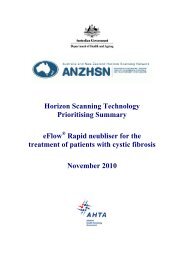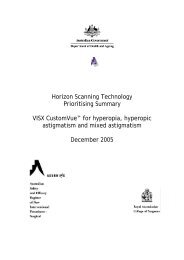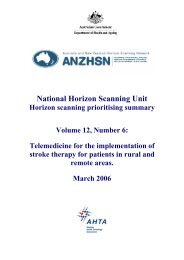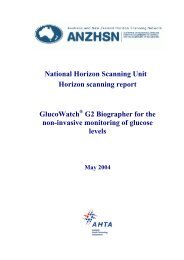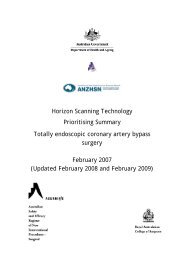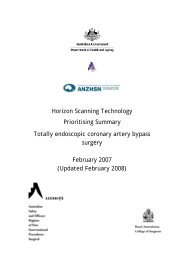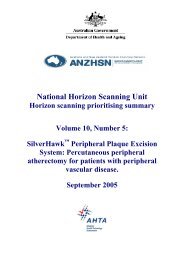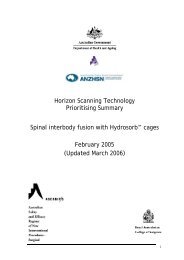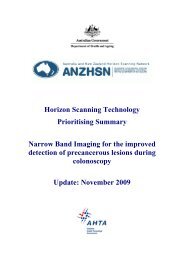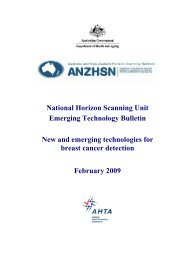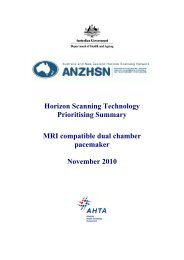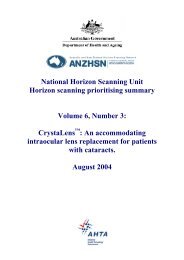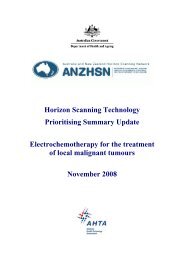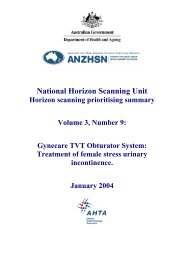Microwave ablation for lung cancer - the Australia and New Zealand ...
Microwave ablation for lung cancer - the Australia and New Zealand ...
Microwave ablation for lung cancer - the Australia and New Zealand ...
You also want an ePaper? Increase the reach of your titles
YUMPU automatically turns print PDFs into web optimized ePapers that Google loves.
Horizon Scanning Technology<br />
Prioritising Summary<br />
<strong>Microwave</strong> <strong>ablation</strong> <strong>for</strong> <strong>lung</strong> <strong>cancer</strong><br />
August 2010
© Commonwealth of <strong>Australia</strong> 2010<br />
ISBN<br />
Publications Approval Number:<br />
This work is copyright. You may download, display, print <strong>and</strong> reproduce this material in<br />
unaltered <strong>for</strong>m only (retaining this notice) <strong>for</strong> your personal, non-commercial use or use within<br />
your organisation. Apart from any use as permitted under <strong>the</strong> Copyright Act 1968, all o<strong>the</strong>r rights<br />
are reserved. Requests <strong>and</strong> inquiries concerning reproduction <strong>and</strong> rights should be addressed to<br />
Commonwealth Copyright Administration, Attorney General’s Department, Robert Garran<br />
Offices, National Circuit, Canberra ACT 2600 or posted at http://www.ag.gov.au/cca<br />
Electronic copies can be obtained from http://www.horizonscanning.gov.au<br />
Enquiries about <strong>the</strong> content of <strong>the</strong> report should be directed to:<br />
HealthPACT Secretariat<br />
Department of Health <strong>and</strong> Ageing<br />
MDP 106<br />
GPO Box 9848<br />
Canberra ACT 2606<br />
AUSTRALIA<br />
DISCLAIMER: This report is based on in<strong>for</strong>mation available at <strong>the</strong> time of research cannot be<br />
expected to cover any developments arising from subsequent improvements health technologies.<br />
This report is based on a limited literature search <strong>and</strong> is not a definitive statement on <strong>the</strong> safety,<br />
effectiveness or cost-effectiveness of <strong>the</strong> health technology covered.<br />
The Commonwealth does not guarantee <strong>the</strong> accuracy, currency or completeness of <strong>the</strong><br />
in<strong>for</strong>mation in this report. This report is not intended to be used as medical advice <strong>and</strong> intended to<br />
be used to diagnose, treat, cure or prevent any disease, nor should it be used <strong>the</strong>rapeutic purposes<br />
or as a substitute <strong>for</strong> a health professional's advice. The Commonwealth does not accept any<br />
liability <strong>for</strong> any injury, loss or damage incurred by use of or reliance <strong>the</strong> in<strong>for</strong>mation.<br />
The production of <strong>the</strong>se Horizon scanning prioritising summaries was overseen by <strong>the</strong> Health<br />
Policy Advisory Committee on Technology (HealthPACT). HealthPACT comprises<br />
representatives from health departments in all states <strong>and</strong> territories, <strong>the</strong> <strong>Australia</strong> <strong>and</strong> <strong>New</strong><br />
Zeal<strong>and</strong> governments; MSAC <strong>and</strong> ASERNIP-S. The <strong>Australia</strong>n Health Ministers’ Advisory<br />
Council (AHMAC) supports HealthPACT through funding.<br />
This Horizon scanning prioritising summary was prepared by Ms Deanne Leopardi from <strong>the</strong><br />
<strong>Australia</strong>n Safety <strong>and</strong> Efficacy Register of <strong>New</strong> Interventional Procedures – Surgical (ASERNIP-<br />
S).
PRIORITISING SUMMARY<br />
REGISTER ID<br />
S000115<br />
NAME OF TECHNOLOGY<br />
MINIMALLY INVASIVE MICROWAVE ABLATION FOR<br />
LUNG CANCER<br />
PURPOSE AND TARGET GROUP<br />
TO OFFER PATIENTS WITH A MINIMALLY INVASIVE<br />
NON-SURGICAL TREATMENT ALTERNATIVE FOR<br />
LUNG MALIGNANCIES<br />
STAGE OF DEVELOPMENT (IN AUSTRALIA)<br />
Yet to emerge Established<br />
Experimental Established but changed indication<br />
or modification of technique<br />
Investigational Should be taken out of use<br />
<br />
Nearly established<br />
AUSTRALIAN THERAPEUTIC GOODS ADMINISTRATION APPROVAL<br />
Yes ARTG number 151425; 152043;<br />
No 152044; 152046;<br />
Not applicable 157722<br />
INTERNATIONAL UTILISATION<br />
COUNTRY<br />
China<br />
Germany<br />
Greece<br />
Italy<br />
Japan<br />
United Kingdom<br />
United States<br />
LEVEL OF USE<br />
Trials Underway or Completed Limited Use Widely Diffused<br />
<br />
<br />
<br />
<br />
<br />
<br />
<br />
IMPACT SUMMARY<br />
Minimally invasive, image-guided, microwave <strong>ablation</strong> uses heat generated from<br />
microwave energy to destroy <strong>lung</strong> tumours. <strong>Microwave</strong> <strong>ablation</strong> potentially offers<br />
patients with significant cardiorespiratory comorbidities who may not be eligible <strong>for</strong><br />
traditional surgical intervention with a minimally invasive, non-surgical treatment of <strong>lung</strong><br />
<strong>cancer</strong>.<br />
<strong>Microwave</strong> <strong>ablation</strong> <strong>for</strong> <strong>lung</strong> <strong>cancer</strong><br />
August 2010<br />
1
BACKGROUND<br />
Lung <strong>cancer</strong> is a disease of uncontrolled cell growth in <strong>the</strong> tissues of <strong>the</strong> <strong>lung</strong>s. Primary<br />
<strong>lung</strong> tumours can be classified as small cell <strong>lung</strong> <strong>cancer</strong>s or non-small cell <strong>lung</strong> <strong>cancer</strong>s.<br />
Small cell <strong>lung</strong> <strong>cancer</strong> is aggressive, fast-growing, <strong>and</strong> accounts <strong>for</strong> approximately 15%<br />
of all diagnosed <strong>lung</strong> <strong>cancer</strong>s (Dugdale et al 2009). These types of <strong>cancer</strong>s are also almost<br />
exclusively associated with cigarette smoking (Dugdale et al 2009). Non-small cell <strong>lung</strong><br />
<strong>cancer</strong> is far more common <strong>and</strong> has a slower rate of growth than small cell <strong>lung</strong> <strong>cancer</strong>.<br />
Due to <strong>the</strong> rapid growth rate of small cell <strong>lung</strong> <strong>cancer</strong> <strong>and</strong> its tendency to metastasise,<br />
<strong>the</strong>se tumours are generally treated with chemo<strong>the</strong>rapy <strong>and</strong> not surgery (Dugdale et al<br />
2009). Traditional first line treatment <strong>for</strong> patients with non-small cell <strong>lung</strong> <strong>cancer</strong> (that<br />
has not spread beyond nearby lymph nodes) is surgery, which may involve <strong>the</strong> removal of<br />
<strong>the</strong> lobes of <strong>the</strong> <strong>lung</strong> (lobectomy), or a small part of <strong>the</strong> <strong>lung</strong> (wedge or segment<br />
removal), or <strong>the</strong> entire <strong>lung</strong> (pneumonectomy) (Chen 2009).<br />
More than 20% of patients with early stage <strong>lung</strong> <strong>cancer</strong>s are ineligible <strong>for</strong> surgery due to<br />
<strong>the</strong>ir age or underlying comorbidities (such as poor cardiorespiratory reserve) (Abbas et<br />
al 2009); in <strong>the</strong>se patients, less invasive, non-surgical means of curative treatment are<br />
required (Simon et al 2005). In addition to this, postoperative mortality in patients who<br />
are considered fit <strong>for</strong> surgical resection is considerably high. Previously, radio<strong>the</strong>rapy<br />
alone or radio<strong>the</strong>rapy in conjunction with a cisplatin-based chemo<strong>the</strong>rapeutic agent was<br />
<strong>the</strong> only viable alternative to surgery; however, <strong>the</strong> overall efficacy of <strong>the</strong>se treatments<br />
has been proven to be significantly less than that of surgery (Wasser et al 2008).<br />
For several decades <strong>the</strong> effect of (increased) heat on <strong>cancer</strong> cells has been known.<br />
Temperatures as low as 41 o C have been shown to cause death in <strong>cancer</strong> cells in in-vitro<br />
models (Wasser et al 2008). This, coupled with improvements in real-time imaging (such<br />
as computer tomographic fluroscopy), has allowed <strong>the</strong> development of minimally<br />
invasive, image-guided treatment of <strong>cancer</strong> using hyper<strong>the</strong>rmia (high temperatures).<br />
Current techniques which use hyper<strong>the</strong>rmia to induce <strong>cancer</strong> cell death include<br />
radiofrequency <strong>ablation</strong>, laser <strong>ablation</strong>, high-frequency ultrasound <strong>ablation</strong>, <strong>and</strong> most<br />
recently microwave <strong>ablation</strong>. Temperatures commonly used <strong>for</strong> <strong>ablation</strong> procedures<br />
generally range from 60 to 100 o C; at <strong>the</strong>se temperatures cellular proteins are rapidly<br />
denatured as are nucleic acid-histone protein complexes, resulting in near-instantaneous<br />
cell death, followed by coagulation necrosis over subsequent days (Wasser et al 2008). In<br />
<strong>the</strong> <strong>lung</strong> specifically, normally aerated parenchyma surrounding <strong>the</strong> tumour bed insulate<br />
<strong>the</strong> adjacent normal tissue from <strong>the</strong>rmal injury (Wasser et al 2008).<br />
The main objectives of pulmonary <strong>ablation</strong> includes eradication of all viable malignant<br />
cells in <strong>the</strong> target volume with a safety margin to ensure complete eradication <strong>and</strong><br />
minimisation of damage to certain targeted volumes to provide good functioning reserve<br />
<strong>for</strong> <strong>the</strong> rest of <strong>the</strong> <strong>lung</strong> (Vogl et al 2009). Potential advantages of local tumour <strong>ablation</strong><br />
over surgical resection may include selective damage, minimal treatment morbidity <strong>and</strong><br />
mortality, less breathing impairment in patients with borderline <strong>lung</strong> function through<br />
sparing healthy <strong>lung</strong> tissue, repeatability, fairly low costs, good imaging during <strong>the</strong><br />
procedure <strong>and</strong> at follow-up, <strong>and</strong> a gain in quality of life with less pain <strong>and</strong> short<br />
hospitalisation (Vogl et al 2009).<br />
<strong>Microwave</strong> <strong>ablation</strong> <strong>for</strong> <strong>lung</strong> <strong>cancer</strong><br />
August 2010<br />
2
Of <strong>the</strong> ablative modalities utilised <strong>for</strong> <strong>lung</strong> <strong>cancer</strong> treatment, radiofrequency <strong>ablation</strong> has<br />
been in use <strong>for</strong> <strong>the</strong> longest period of time <strong>and</strong> has demonstrated <strong>the</strong> most clinical success<br />
to date. <strong>Microwave</strong> <strong>ablation</strong> is said to offer many of <strong>the</strong> benefits of radiofrequency<br />
<strong>ablation</strong>, as well as offer some <strong>the</strong>oretical advantages over radiofrequency <strong>ablation</strong>. These<br />
advantages include consistently greater intratumoral temperatures, faster <strong>ablation</strong> time,<br />
diminished procedural pain, <strong>the</strong> ability to treat without grounding pads, <strong>and</strong> larger tumour<br />
<strong>ablation</strong> volumes with use of multiple applicators (Carrafiello et al 2008).<br />
<strong>Microwave</strong> <strong>ablation</strong> is generally per<strong>for</strong>med as a percutaneous outpatient procedure under<br />
image guidance. Image guidance is used to localise <strong>the</strong> tumour, <strong>and</strong> depending on <strong>the</strong> size<br />
<strong>and</strong> location of <strong>the</strong> tumour <strong>the</strong> best percutaneous entry route, number <strong>and</strong> type of<br />
microwave applicators to be employed <strong>and</strong> <strong>the</strong> length of treatment is determined (Wolf et<br />
al 2008). <strong>Microwave</strong> applicators are typically thin 14.5 gauge antennas introduced<br />
percutaneously into <strong>the</strong> tumour bed (McTaggart <strong>and</strong> Dupuy 2007). Tumours greater than<br />
2cm in diameter may require <strong>the</strong> use of multiple applicators concurrently (Wasser et al<br />
2008). Actual treatment time may vary from 7-10 minutes (McTaggart <strong>and</strong> Dupuy 2007).<br />
<strong>Microwave</strong> <strong>ablation</strong> utilises electromagnetic waves to agitate adjacent water molecules,<br />
creating <strong>the</strong>rmal friction <strong>and</strong> coagulative necrosis in <strong>the</strong> target tissue (Iannitti et al 2007)<br />
The energy spectrum used by microwave <strong>ablation</strong> extends from 300 MHz to 300 GHz,<br />
which is considerably higher than <strong>the</strong> frequency range used by radiofrequency <strong>ablation</strong>,<br />
although <strong>the</strong> microwave probes available <strong>for</strong> clinical use usually only operate between<br />
900-2450 MHz (Carrafiello et al 2008).<br />
CLINICAL NEED AND BURDEN OF DISEASE<br />
Cancer of <strong>the</strong> <strong>lung</strong> is <strong>the</strong> most common cause of <strong>cancer</strong> in <strong>Australia</strong> <strong>and</strong> <strong>the</strong> world, <strong>and</strong><br />
relative survival after diagnosis remain very poor compared with o<strong>the</strong>r types of <strong>cancer</strong><br />
(<strong>Australia</strong>n Institute of Health <strong>and</strong> Welfare 2003). Lung <strong>cancer</strong> is also <strong>the</strong> leading cause<br />
of <strong>cancer</strong>-related death in <strong>Australia</strong>, <strong>and</strong> <strong>the</strong> third leading cause of all deaths in <strong>Australia</strong><br />
(The <strong>Australia</strong>n Lung Foundation 2010). Approximately 9,100 <strong>Australia</strong>ns are diagnosed<br />
with <strong>lung</strong> <strong>cancer</strong> each year, 7,600 of which will eventually die as a result of <strong>the</strong> disease.<br />
This equates to almost 20 <strong>lung</strong> <strong>cancer</strong>-related deaths per day, every day of <strong>the</strong> year (The<br />
<strong>Australia</strong>n Lung Foundation 2010).<br />
In patients with <strong>lung</strong> malignancies, significant proportions have cardiorespiratory<br />
comorbidities which do not allow <strong>the</strong>m to undergo traditional surgical resection (Wasser<br />
et al 2008). Of <strong>the</strong> 20-30% of patients with <strong>lung</strong> malignancies who are fit <strong>for</strong> surgical<br />
treatment, postoperative mortality is significant (Wasser et al 2008). One trial of 2,200<br />
patients reported morality in 6.2% of patients following pneumonectomy, 2.9% following<br />
lobectomy, <strong>and</strong> 1.4% following sublobar resection (Ginsberg et al 1983).<br />
DIFFUSION<br />
Since <strong>the</strong> year 2000, when <strong>the</strong> first use of <strong>the</strong>rmal <strong>ablation</strong> <strong>for</strong> <strong>lung</strong> <strong>cancer</strong> was reported,<br />
<strong>the</strong>re has been a rapid increase in <strong>the</strong> use of <strong>the</strong> procedure (Vogl et al 2009). In 2009 it<br />
was expected that <strong>the</strong> number of <strong>the</strong>rmal <strong>ablation</strong> procedures taking place to treat thoracic<br />
malignancy would exceed 150,000 per year by 2010 (Vogl et al 2009).<br />
<strong>Microwave</strong> <strong>ablation</strong> <strong>for</strong> <strong>lung</strong> <strong>cancer</strong><br />
August 2010<br />
3
There are currently three microwave ablative devices included on <strong>the</strong> <strong>Australia</strong>n Register<br />
of Therapeutic Goods (ARTG) <strong>for</strong> use in <strong>Australia</strong> (Therapeutic Goods Administration<br />
[TGA] 2010). The manufacturer name <strong>and</strong> intended purpose of each device, as well as its<br />
ARTG number <strong>and</strong> start date are presented below in Table 1. It is unlikely <strong>the</strong>se devices<br />
are being used to treat <strong>lung</strong> <strong>cancer</strong> in <strong>Australia</strong>, according to <strong>the</strong> Medicare Benefits<br />
Schedule (MBS) <strong>the</strong> main indications <strong>for</strong> microwave <strong>ablation</strong> are menorrhagia <strong>and</strong><br />
prostate <strong>cancer</strong> (MBS 2010). There are also three FDA-approved microwave <strong>ablation</strong><br />
devices in use in <strong>the</strong> United States (Abbas et al 2009).<br />
Table 1: <strong>Microwave</strong> <strong>ablation</strong> devices with TGA approval (TGA 2010).<br />
ARTG<br />
Number<br />
Manufacturer Device Intended purpose ARTG<br />
start date<br />
151425 Microsulis Ltd Hypertermia A system used to deliver<br />
02/04/2008<br />
system,<br />
microwave<br />
microwave energy to soft tissue <strong>for</strong><br />
<strong>the</strong> purpose of coagulation <strong>and</strong><br />
<strong>ablation</strong><br />
152043;<br />
152044;<br />
152045;<br />
152046<br />
Valleylab Inc<br />
02/05/2008<br />
157722 Scanmedics<br />
Pty/Ltd<br />
Hyper<strong>the</strong>rmia<br />
applicator,<br />
microwave,<br />
intracorporeal;<br />
Pump,<br />
generalpurpose<br />
Hyper<strong>the</strong>rmia<br />
system,<br />
microwave<br />
Intended <strong>for</strong> use with <strong>the</strong><br />
microwave generator <strong>for</strong> <strong>the</strong><br />
coagulation of soft tissue. The<br />
antenna(s) work in conjunction<br />
with <strong>the</strong> microwave <strong>ablation</strong> pump<br />
<strong>and</strong> microwave pump tubing set to<br />
provide a cooled shaft suitable <strong>for</strong><br />
use in percutaneous, laparoscopic,<br />
<strong>and</strong> intraoperative <strong>ablation</strong><br />
procedures<br />
Treat lesions using microwave<br />
hyper<strong>the</strong>rmia<br />
10/12/2008<br />
COMPARATORS<br />
Surgical resection with a curative intent remains <strong>the</strong> mainstay of treatment <strong>for</strong> early stage<br />
non-small cell <strong>lung</strong> <strong>cancer</strong> (Wasser et al 2008). In patients who are ineligible <strong>for</strong> surgical<br />
resection, minimally invasive, non-surgical alternatives to <strong>cancer</strong> treatment may include<br />
radio<strong>the</strong>rapy (alone, or in conjunction with chemo<strong>the</strong>rapy), or modalities which utilise<br />
extreme temperature to induce <strong>cancer</strong> cell-death, including radiofrequency <strong>ablation</strong>, laser<br />
<strong>ablation</strong>, <strong>and</strong> high-frequency ultrasound <strong>ablation</strong>. In general, <strong>the</strong>se hyper<strong>the</strong>rmal ablative<br />
techniques differ only by <strong>the</strong>ir physical method of generating heat while <strong>the</strong> tissue<br />
damage <strong>the</strong>y achieve is related directly to tissue temperature (Vogl et al 2009).<br />
The main comparator <strong>for</strong> microwave <strong>ablation</strong> would be <strong>the</strong> current gold st<strong>and</strong>ard <strong>for</strong> <strong>the</strong><br />
treatment of <strong>lung</strong> malignancies, which is traditional surgical resection.<br />
<strong>Microwave</strong> <strong>ablation</strong> <strong>for</strong> <strong>lung</strong> <strong>cancer</strong><br />
August 2010<br />
4
SAFETY AND EFFECTIVENESS ISSUES<br />
Two case series studies were identified as relevant <strong>for</strong> inclusion (Wolf et al 2008; He et al<br />
2006). These studies used minimally invasive microwave <strong>ablation</strong> to treat <strong>lung</strong><br />
malignancies with a curative intent.<br />
Wolf et al (2008) conducted a retrospective evaluation of 50 patients (28 men, 22<br />
women), with a mean age of 70 years (st<strong>and</strong>ard deviation [SD], 15 years), who underwent<br />
computed tomography (CT) guided percutaneous microwave <strong>ablation</strong> of 82<br />
intraparenchymal pulmonary masses (in 66 ablative procedures) between November 2003<br />
<strong>and</strong> August 2006. All of <strong>the</strong> included patients were deemed inoperable, or refused<br />
surgery. Follow-up CT was per<strong>for</strong>med at 1-, 3-, <strong>and</strong> 6- month intervals after <strong>the</strong> initial<br />
<strong>ablation</strong> session, with an overall mean follow-up period of 10 months (SD, 6.8 months)<br />
<strong>for</strong> all patients. Common terminology criteria <strong>for</strong> adverse events (CTCAE 1 ) were used to<br />
grade <strong>the</strong> severity of <strong>the</strong> complications experienced in <strong>the</strong> patient population.<br />
He et al (2006) retrospectively evaluated ultrasound (US) guided percutaneous<br />
microwave <strong>ablation</strong> in 12 patients with (n=16) peripheral <strong>lung</strong> <strong>cancer</strong> treated between<br />
December 2002 <strong>and</strong> September 2003. Of <strong>the</strong>se patients, 12 were men <strong>and</strong> 5 women with<br />
an average age of 47.5 years (range: 31-69 years). Indications <strong>for</strong> microwave <strong>ablation</strong><br />
included refusal of surgical resection (n=5), poor cardiopulmonary reserve (n=3), <strong>and</strong><br />
experience of severe side effects (including vomiting, diarrhoea, renal failure) from<br />
previous chemo/radio<strong>the</strong>rapy (n=4). Contrast-enhanced CT imaging of <strong>the</strong> chest was<br />
carried out in all patients be<strong>for</strong>e <strong>and</strong> after <strong>the</strong> ablative session. Colour Doppler flow<br />
imaging (CDFI 2 ) with high sensitivity was specifically used to assess blood vessels<br />
inside <strong>and</strong> in <strong>the</strong> periphery of <strong>the</strong> tumours. Overall mean follow-up was 20 months<br />
(range: 6-40 months).<br />
Safety<br />
There were no intraprocedural deaths reported in <strong>the</strong> study by Wolf et al (2008). One<br />
death occurred at approximately 9 months postoperatively as a result of a delayed<br />
complication (haemoptysis). Pneumothorax occurred after 39% (26/66) of procedures, <strong>the</strong><br />
majority of which (18/26, 69%) were considered mild (grade 1) using CTCAE <strong>and</strong> did<br />
not require intervention. Twelve per cent (8/26) of pneumothorax events were considered<br />
moderate to severe (grade 2) <strong>and</strong> required chest tube placement. Intraprocedural skin<br />
burns occurred as a result of 3% (2/66) of <strong>ablation</strong> procedures; one patient’s burn was<br />
grade 3 <strong>and</strong> <strong>the</strong> o<strong>the</strong>r grade 2. One patient (2% of procedures) experienced significant<br />
pain (5/10-point scale <strong>for</strong> chest pain) localised to <strong>the</strong> site of <strong>ablation</strong> (grade 1). Analgesic<br />
<strong>the</strong>rapy offered pain relief in this patient until <strong>the</strong>y were discharged with a prescription<br />
<strong>for</strong> more pain medication if necessary. Ano<strong>the</strong>r patient (2% of procedures) was diagnosed<br />
with grade 1 post<strong>ablation</strong> syndrome, defined as a constellation of productive cough with<br />
1 Common Terminology Criteria <strong>for</strong> Adverse Events: Grade 1: mild adverse event, Grade 2:<br />
moderate adverse event, Grade 3: severe adverse event, Grade 4: life-threatening or disabling<br />
adverse event, Grade 5: death related adverse event.<br />
2 Colour Doppler flow imaging: Grade 1: <strong>the</strong>re is no blood flow in <strong>the</strong> tumour, Grade I: <strong>the</strong>re is<br />
one or two tiny branch vessels (2mm in diameter) in <strong>the</strong> tumour,<br />
Grade III: <strong>the</strong>re are more than two feeding vessels in <strong>the</strong> tumour.<br />
<strong>Microwave</strong> <strong>ablation</strong> <strong>for</strong> <strong>lung</strong> <strong>cancer</strong><br />
August 2010<br />
5
or without minor haemoptysis, residual soreness in <strong>the</strong> treated area, <strong>and</strong> fever occurring<br />
several days after <strong>the</strong> procedure. All signs <strong>and</strong> symptoms were resolved in this patient<br />
within 3-4 days. Ten patients (15% of procedures) were admitted to hospital after<br />
<strong>ablation</strong>, nine of <strong>the</strong>se were readmitted <strong>for</strong> continued monitoring or pneumothorax that<br />
was treated with chest tubes <strong>and</strong> wall suction, <strong>and</strong> were discharged home in 1-2 days. The<br />
remaining patient was admitted to <strong>the</strong> intensive care unit (ICU) due to acute respiratory<br />
distress syndrome <strong>and</strong> seizure activity periprocedurally (grade 4). This patient was moved<br />
from ICU to a regular ward after 1 week <strong>and</strong> discharged from hospital shortly after.<br />
All patients reported in <strong>the</strong> study by He et al (2006) experienced mild to moderate pain in<br />
<strong>the</strong> microwave applicator insertion site during, <strong>and</strong> up to one week following, <strong>the</strong> <strong>ablation</strong><br />
procedure. Seven patients experienced low-grade fever that subsided with symptomatic<br />
treatment <strong>and</strong> one patient experienced a slight skin scald <strong>for</strong> 1 month. Ano<strong>the</strong>r patient had<br />
minimal pneumothorax which spontaneously absorbed in 1 week. There was no incidence<br />
of severe complication requiring surgical intervention reported in this study.<br />
Effectiveness<br />
Wolf et al (2008) reported initial treatment success (defined by no detectable<br />
enhancement on <strong>the</strong> initial post<strong>ablation</strong> CT scans) following 95% (63/66) of <strong>ablation</strong><br />
procedures. Technique effectiveness was proven by a low rate (6%) of re<strong>ablation</strong> required<br />
within a 6 month period following <strong>the</strong> initial procedure. Recurrent (residual) disease at<br />
<strong>the</strong> <strong>ablation</strong> site was evident in 26% (13/50) of patients, with an index tumour size larger<br />
than 3cm predictive of residual disease in <strong>the</strong>se patients (shown using logistic regression<br />
analysis) (P=0.01). Recurrent disease distant to <strong>the</strong> <strong>ablation</strong> site was apparent in 22%<br />
(11/50) of patients. Progressive disease within <strong>the</strong> treated lobe (but not at <strong>the</strong> <strong>ablation</strong><br />
site) was found in 11 patients <strong>and</strong> new metastatic foci in untreated lobes or organs were<br />
found in 18% (2/11) of <strong>the</strong>se patients. Consequently, 1-year local control rate was 67%<br />
(SD, 10%), with a mean of 16.2 months (SD, 1.3 months) to first recurrence distant from<br />
<strong>the</strong> <strong>ablation</strong> site.<br />
The Kaplan-Meier median time to death from any cause <strong>for</strong> all patients was 19 months<br />
(SD,1 month), <strong>and</strong> <strong>the</strong> 1-, 2- <strong>and</strong> 3- year actuarial survival rates were 65% (SD, 7%), 55%<br />
(SD, 9%), <strong>and</strong> 45% (SD, 11%), respectively. Analysis of <strong>cancer</strong>-specific mortality<br />
yielded a median time to death of 22 months (SD, 1 month) <strong>and</strong> 1-, 2-, <strong>and</strong> 3- year<br />
survival rates of 83% (SD, 6%), 73% (SD, 9%), <strong>and</strong> 61% (SD, 13%). Index tumour size<br />
did not affect <strong>cancer</strong>-specific mortality rates (P=0.7) or actuarial survival (P=0.52).<br />
There were no cases of recurrence reported in <strong>the</strong> study by He et al (2006). Fifty-eight per<br />
cent (7/12) of patients survived <strong>the</strong> entire follow-up period, with deaths due to metastases<br />
occurring in <strong>the</strong> remaining patients at 10, 11, 12, 18, <strong>and</strong> 38 months postoperative.<br />
Clinical symptoms disappeared 1-4 weeks following treatment in five patients <strong>and</strong><br />
alleviated in seven patients. Blood flow status in <strong>the</strong> tumours be<strong>for</strong>e <strong>and</strong> after treatment<br />
are presented in Table 2. All ablated tumours shrank following microwave <strong>ablation</strong><br />
(remarkable shrinkage in 10 patients <strong>and</strong> mild shrinkage in 6 patients), with invisible or<br />
decreased blood flow. US guided biopsy took place in four patients <strong>and</strong> complete<br />
necrosis of treated tumours was evident in each.<br />
<strong>Microwave</strong> <strong>ablation</strong> <strong>for</strong> <strong>lung</strong> <strong>cancer</strong><br />
August 2010<br />
6
Table 2:<br />
Blood flow status of 16 tumours on CDFI be<strong>for</strong>e <strong>and</strong> after <strong>ablation</strong><br />
Grade 0 Grade I Grade II Grade III<br />
Preoperation 0 4 8 4<br />
Postoperation 10 4 2 0<br />
P value
HEALTHPACT ASSESSMENT<br />
Based on <strong>the</strong> potential benefit of microwave <strong>ablation</strong> <strong>for</strong> treatment of <strong>lung</strong> malignancies,<br />
as well as <strong>the</strong> potential benefit of all newly emerging <strong>the</strong>rmo-ablative techniques <strong>for</strong> <strong>the</strong><br />
treatment of <strong>cancer</strong> it is recommended that a horizon scanning report be carried out on all<br />
<strong>the</strong>rmo-ablative treatments across a variety of <strong>cancer</strong>s.<br />
Horizon Scanning Report Full Health Technology Assessment<br />
Monitor Archive<br />
Refer Decision pending<br />
NUMBER OF STUDIES INCLUDED<br />
Total number of studies 2<br />
Level IV evidence 2<br />
REFERENCES<br />
Abbas G, Pennathur A, L<strong>and</strong>reneau RJ, Luketich JD. Radiofrequency <strong>and</strong> microwave<br />
<strong>ablation</strong> of <strong>lung</strong> tumors. J Surg Oncol 2009; 100(8): 645-650.<br />
<strong>Australia</strong>n Institute of Health <strong>and</strong> Welfare <strong>and</strong> Australasian Association of Cancer<br />
Registries (AACR) 2003. Cancer survival in <strong>Australia</strong> 1992–1997: geographic categories<br />
<strong>and</strong> socioeconomic status. AIHW cat. no. CAN 17. Canberra: <strong>Australia</strong>n Institute of<br />
Health <strong>and</strong> Welfare (Cancer Series no. 22).<br />
The <strong>Australia</strong>n Lung Foundation. Lung <strong>cancer</strong>. Last Updated 2009. http://www.<strong>lung</strong><br />
foundation.com.au/content/view/4/4/ [Accessed June 2010].<br />
Carrafiello G, Lagana D, Mangini M, Fontana F, Dionigi G, Boni L, Rovera F, Cuffari S,<br />
Fugazzola C. <strong>Microwave</strong> tumors <strong>ablation</strong>: principles, clinical applications <strong>and</strong> review of<br />
preliminary experiences. Int J Surg 2008; 6 Suppl 1: S65-S69.<br />
Chen TB. Medline Plus: Lung Cancer – non-small cell. Last Updated September 14 th<br />
2009. http://www.nlm.nih.gov/medlineplus/ency/article/007194.htm [Accessed June<br />
2010].<br />
Dodd GM, Soulen MC, Kane RA, Livraghi T, Lees WR, Yamashita Y, Gillams AR,<br />
Karahan OI, Rhim H. Minimally invasive treatment of malignant hepatic tumors: at <strong>the</strong><br />
threshold of a major breakthrough. Radiographics 2000; 20 (1): 9–27.<br />
Dugdale DC, Chen YB, Zieve D. Medline Plus: <strong>lung</strong> <strong>cancer</strong> – small cell. Last Updated<br />
September 8 th 2009. http://www.nlm.nih.gov/medlineplus/ency/article/000122.htm<br />
[Accessed June 2010].<br />
Ginsberg RJ, Hill LD, Eagen RT, Thomas P, Mountain CF, Deslauriers J, Fry WA, Butz<br />
RO, Goldberg M, Waters PF, et al. Modern thirty-day operative mortality <strong>for</strong> surgical<br />
resections in <strong>lung</strong> <strong>cancer</strong>. J Thorac Cardiovasc Surg 1983; 86(5): 654-658.<br />
<strong>Microwave</strong> <strong>ablation</strong> <strong>for</strong> <strong>lung</strong> <strong>cancer</strong><br />
August 2010<br />
8
He W, Hu XD, Wu DF, Guo L, Zhang LZ, Xiang DY, Ning B. Ultrasonography-guided<br />
percutaneous microwave <strong>ablation</strong> of peripheral <strong>lung</strong> <strong>cancer</strong>. Clin Imaging 2006; 30(4):<br />
234-241.<br />
Iannitti DA, Martin RCG, Simon CJ, Hope WW, <strong>New</strong>comb WL, McMasters KM, Dupuy<br />
D. Hepatic tumor <strong>ablation</strong> with clustered microwave antennae: <strong>the</strong> US phase II trial. HPB<br />
2007; 9 (2): 120–124.<br />
McTaggart RA <strong>and</strong> Dupuy DE. Thermal <strong>ablation</strong> of <strong>lung</strong> tumors. Tech Vasc Interv Radiol<br />
2007; 10(2): 102-113.<br />
Medicare Benefits Schedule (MBS). Search <strong>the</strong> MBS: microwave. Last Updated June<br />
2010. http://www9.health.gov.au/mbs/search.cfm?q=microwave&sopt=S [Accessed June<br />
2010].<br />
Simon CJ, Dupuy DE, Mayo-Smith WW. <strong>Microwave</strong> <strong>ablation</strong>: principles <strong>and</strong><br />
applications. Radiographics 2005; 25 Suppl 1: S69-S83.<br />
Therapeutic Goods Administration. The <strong>Australia</strong>n Register of Therapeutic Goods. Last<br />
Updated June 16 th 2010. https://www.ebs.tga.gov.au/ebs/ANZTPAR/PublicWeb.nsf/cu<br />
Medicines?OpenView [Accessed June 2010].<br />
Vogl TJ, Naguib NN, Lehnert T, Nour-Eldin NE. Radiofrequency, microwave <strong>and</strong> laser<br />
<strong>ablation</strong> of pulmonary neoplasms: Clinical studies <strong>and</strong> technical considerations-Review<br />
article. Eur J Radiol 2009;<br />
Wasser EJ <strong>and</strong> Dupuy DE. <strong>Microwave</strong> <strong>ablation</strong> in <strong>the</strong> treatment of primary <strong>lung</strong> tumors.<br />
Semin Respir Crit Care Med 2008; 29(4): 384-394.<br />
Wolf FJ, Gr<strong>and</strong> DJ, Machan JT, Dipetrillo TA, Mayo-Smith WW, Dupuy DE.<br />
<strong>Microwave</strong> <strong>ablation</strong> of <strong>lung</strong> malignancies: effectiveness, CT findings, <strong>and</strong> safety in 50<br />
patients. Radiology 2008; 247(3): 871-879.<br />
SOURCES OF FURTHER INFORMATION<br />
Padda S, Kothary N, Donington J, Cannon W, Loo BW, Jr., Kee S, Wakelee H.<br />
Complications of ablative <strong>the</strong>rapies in <strong>lung</strong> <strong>cancer</strong>. Clin Lung Cancer 2008; 9(2): 122-<br />
126.<br />
SEARCH CRITERIA TO BE USED<br />
((microwave <strong>ablation</strong>) AND (<strong>lung</strong> <strong>cancer</strong>))<br />
HEALTH PACT DECISION<br />
Horizon Scanning Report Full Health Technology Assessment<br />
Monitor Archive<br />
Refer Decision pending<br />
<strong>Microwave</strong> <strong>ablation</strong> <strong>for</strong> <strong>lung</strong> <strong>cancer</strong><br />
August 2010<br />
9
PRIORITY RATING<br />
High Medium Low<br />
<strong>Microwave</strong> <strong>ablation</strong> <strong>for</strong> <strong>lung</strong> <strong>cancer</strong><br />
August 2010<br />
10



